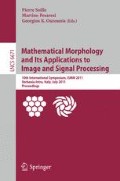Abstract
This paper is focused on adaptive viscous morphology in the context of the General Adaptive Neighborhood Image Processing (GANIP) approach [1,2]. A local adaptive neighborhood is defined for each image point, depending on the intensity function of the image. These so-called General Adaptive Neighborhoods (GANs) are used as adaptive structuring elements for Mathematical Morphology (MM) [1,3]. In this paper, GAN-based viscous MM is introduced to adjust the filtering activity to the image gray levels. The proposed GAN viscous morphological filters are successfully applied on real application examples in image restoration and enhancement.
Access this chapter
Tax calculation will be finalised at checkout
Purchases are for personal use only
Preview
Unable to display preview. Download preview PDF.
References
Debayle, J., Pinoli, J.C.: General Adaptive Neighborhood Image Processing - Part I: Introduction and Theoretical Aspects. Journal of Mathematical Imaging and Vision 25(2), 245–266 (2006)
Debayle, J., Pinoli, J.C.: General Adaptive Neighborhood Image Processing - Part II: Practical Application Examples. Journal of Mathematical Imaging and Vision 25(2), 267–284 (2006)
Pinoli, J.C., Debayle, J.: General adaptive neighborhood mathematical morphology. In: IEEE International Conference on Image Processing, Cairo, Egypt, November 7-10, pp. 2249–2252 (2009)
Debayle, J., Pinoli, J.C.: Spatially Adaptive Morphological Image Filtering using Intrinsic Structuring Elements. Image Analysis and Stereology 24(3), 145–158 (2005)
Pinoli, J.C.: A General Comparative Study of the Multiplicative Homomorphic, Log-Ratio and Logarithmic Image Processing Approaches. Signal Processing 58, 11–45 (1997)
Jourlin, M., Pinoli, J.C.: Logarithmic Image Processing: The Mathematical and Physical Framework for the Representation and Processing of Transmitted Images. Advances in Imaging and Electron Physics 115, 129–196 (2001)
Cuisenaire, O.: Locally adaptable mathematical morphology using distance transformations. Pattern Recognition 39(3), 405–416 (2006)
Lerallut, R., Decencière, E., Meyer, F.: Image filtering using morphological amoebas. Image and Vision Computing 25(4), 395–404 (2007)
Bouaynaya, N., Schonfeld, D.: Theoretical foundations of spatially-variant mathematical morphology. Part II: Gray-Level Images. IEEE Transcations on Pattern Analysis and Machine Intelligence 30(5), 837–850 (2008)
Vachier, C.: Upper and lower grey-level adaptive morphological operators. In: International Conference on Advances in Pattern Recognition, Kolkata, India, pp. 77–80 (2009)
Roerdink, J.B.T.M.: Adaptivity and Group Invariance in Mathematical Morphology. In: IEEE International Conference on Image Processing, Cairo, Egypt, November 7-10, pp. 2253–2256 (2009)
Salembier, P., Serra, J.: Flat Zones Filtering, Connected Operators, and Filters by Reconstruction. IEEE Transactions on Image Processing 4(8), 1153–1160 (1995)
Wendt, P.D., Coyle, E.J., Gallagher, N.C.: Stack filters. IEEE Transactions on Acoustics, Speech and Signal Processing 34(4), 898–911 (1986)
Hirata, N.S.T.: Stack filters: from definitions to design algorithms. In: Advances in Imaging and Electron Physics, vol. 152, pp. 1–47. Elsevier, Amsterdam (2008)
Vachier, C., Meyer, F.: The viscous watershed transform. Journal of Mathematical Imaging and Vision 22(2), 251–267 (2005)
Maragos, P., Vachier, C.: A pde formulation for viscous morphological operators with extensions to intensity-adaptive operators. In: IEEE International Conference on Image Processing, pp. 2200–2203 (2008)
Presles, B., Debayle, J., Fevotte, G., Pinoli, J.C.: A novel image analysis method for in-situ monitoring the particle size distribution of batch crystallisation process. Journal of Electronic Imaging 19(3), 1–7 (2010)
Pinoli, J.C., Debayle, J.: Logarithmic adaptive neighborhood image processing (lanip): Introduction, connections to human brightness perception and application issues. Journal on Advances in Signal Processing - Special issue on Image Perception 2007, 22 pages (2007) Article ID 36105
Author information
Authors and Affiliations
Editor information
Editors and Affiliations
Rights and permissions
Copyright information
© 2011 Springer-Verlag Berlin Heidelberg
About this paper
Cite this paper
Debayle, J., Pinoli, JC. (2011). General Adaptive Neighborhood Viscous Mathematical Morphology. In: Soille, P., Pesaresi, M., Ouzounis, G.K. (eds) Mathematical Morphology and Its Applications to Image and Signal Processing. ISMM 2011. Lecture Notes in Computer Science, vol 6671. Springer, Berlin, Heidelberg. https://doi.org/10.1007/978-3-642-21569-8_20
Download citation
DOI: https://doi.org/10.1007/978-3-642-21569-8_20
Publisher Name: Springer, Berlin, Heidelberg
Print ISBN: 978-3-642-21568-1
Online ISBN: 978-3-642-21569-8
eBook Packages: Computer ScienceComputer Science (R0)

